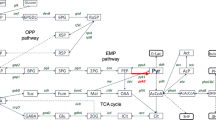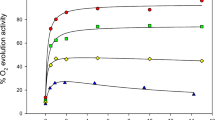Abstract
C4-acid metabolism by isolated bundlesheath chloroplasts, mitochondria and strands of Eriochloa borumensis Hack., a phosphoennolpyruvate-carboxykinase (PEP-CK) species, was investigated. Aspartate, oxaloacetate (OAA) and malate were decarboxylated by strands with several-fold stimulation upon illumination. There was strictly light-dependent decarboxylation of OAA and malate by the chloroplasts, but the chloroplasts did not decarboxylate aspartate in light or dark. PEP was a primary product of OAA or malate decarboxylation by the chloroplasts and its formation was inhibited by 3-(3,4-dichlorophenyl)-1, 1-dimethylurea or NH4Cl. There was very little conversion of PEP to pyruvate by bundle-sheath chloroplasts, mitochondria or strands. Decarboxylation of the three C4-acids by mitochondria was light-independent. Pyruvate was the only product of mitochondrial metabolism of C4-acids, and was apparently transaminated in the cytoplasm since PEP and alanine were primarily exported out of the bundle-sheath strands. Light-dependent C4-acid decarboxylation by the chloroplasts is suggested to be through the PEP-CK, while the mitochondrial C4-acid decarboxylation may proceed through the NAD-malic enzyme (NAD-ME) system. In vivo both aspartate and malate are considered as transport metobolites from mesophyll to bundle-sheath cells in PEP-CK species. Aspartate would be metabolized by the mitochondria to OAA. Part of the OAA may be converted to malate and decarboxylated through NAD-ME, and part may be transported to the chloroplasts for decarboxylation through PEP-CK localized in the chloroplasts. Malate transported from mesophyll cells may serve as carboxyl donor to chloroplasts through the chloroplastic NAD-malate dehydrogenase and PEP-CK. Bundle-sheath strands and chloroplasts fixed 14CO2 at high rates and exhibited C4-acid-dependent O2 evolution in the light. Studies with 3-mercaptopicolinic acid, a specific inhibitor of PEP-CK, have indicated that most (about 70%) of the OAA formed from aspartate is decarboxylated through the chloroplastic PEP-CK and the remaining (about 30%) OAA through the mitochondrial NAD-ME. Pyruvate stimulation of aspartate decarboxylation is discussed; a pyruvate-alanine shuttle and an aspartate-alanine shuttle are proposed between the mesophyll and bundle-sheath cells during aspartate decarboxylation through the PEP-CK and NAD-ME system respectively.
Similar content being viewed by others
Abbreviations
- CK:
-
carboxykinase
- α-Kg:
-
α-ketoglutarate
- ME:
-
malic enzyme
- 3-MPA:
-
3-mercaptopicolinic acid
- OAA:
-
oxaloacetate
- PEP:
-
phosphoenolpyruvate
- R5P:
-
ribose-5-phosphate
References
Bamberger, E.S., Avron, M.: Site of action of inhibitors of carbon dioxide assimilation by whole lettuce chloroplasts. Plant Physiol. 56, 481–485 (1975)
Black, C.C.: Photosynthetic carbon fixation in relation to net CO2 uptake. Ann. Rev. Plant Physiol. 24, 253–286 (1973)
Delieu, T., Walker, D.A.: An improved cathode for the measurement of photosynthetic oxygen evolution by isolated chloroplasts. New Phytol. 71, 201–225 (1972)
Duggleby, R.C., Dennis, D.T.: Pyruvate kinase, a possible regulatory enzyme in higher plants. Plant Physiol. 52, 312–317 (1973)
Edwards, G.E., Kanai, R., Black, C.C.: Phosphoenolpyruvate carboxykinase in leaves of certain plants which fix CO2 by the C4-dicarboxylic acid pathway of photosynthesis. Biochem. Biophys. Res. Commun. 45, 278–285 (1971)
Farineau, J.: Photoassimilation of CO2 by isolated bundle-sheath strands of Zea mays. II. Role of malate as a source of CO2 and reducing power for the photosynthetic activity of isolated bundle-sheath cells of Zea mays. Physiol. Plantarum 33, 310–315 (1976)
Foster, A., Black, C.C.: Changes in pathway of carbon flow in response to CO2 concentration during leaf photosynthesis in Panicum maximum (Abstr.) Amer. Soc. Plant Physiol., Suppl. 57, 306 (1976)
Gutierrez, M., Edwards, G.E., Brown, W.V.: PEP carboxykinase containing species in the Brachiaria group of the subfamily Panicoideae. Biochem. System. Ecol. 4, 47–49 (1976)
Gutierrez, M., Gracen, V.E., Edwards, G.E., Biochemical and cytological relationships in C4 plants. Planta (Berl.) 119, 279–300 (1974)
Hatch, M.D.: The C4-pathway of photosynthesis: mechanism and function. In: CO2 metabolism and plant productivity, pp. 59–81, Burris, R.H., Black, C.C., Eds. Baltimore: University Park Press 1976
Hatch, M.D., Kagawa, T.: Photosynthetic activities of isolated bundle-sheath cells in relation to different mechanisms of C4 pathway photosynthesis. Arch. Biochem. Biophys. 157, 39–53 (1976)
Hatch, M.D., Kagawa, T., Craig, S.: A survey of C4 decarboxylating systems, mitochondria frequency and ultrastructure features in C4 pathway leaves and the subclassification of these species. Aust. J. Plant Physiol. 1, 357–369 (1975)
Huber, S.C., Edwards, G.E.: An evaluation of some parameters required for the enzymatic isolation of cells and protoplasts with CO2 fixation capacity from C3 and C4 grasses. Physiol. Plantarum 35, 203–209 (1975)
Huber, S.C., Kanai, R., Edwards, G.E.: Decarboxylation of malate by isolated bundle-sheath cells of certain plants having the C4-dicarboxylic acid pathway of photosynthesis. Planta (Berl.) 113, 53–66 (1973)
Jomain-Baum, M., Schramm, V.L., Hanson, R.W.: Mechanism of 3-mercaptopicolinic acid inhibition of hepatic phosphoenolpyruvate carboxykinase (GTP). J. biol. Chem. 251, 37–44 (1976)
Kagawa, T., Hatch, M.D.: C4 acids as the source of CO2 for Calvin cycle photosynthesis by bundle sheath cells of the C4 pathway species Atriplex spongiosa. Biochem. Biophys. Res. Commun. 59, 1326–1332 (1974)
Kagawa, T., Hatch, M.D.: Mitochondria as a site of C4 acid decarboxylation in C4-pathway photosynthesis. Arch. Biochem. Biophys. 167, 687–696 (1975)
Kanai, R., Black, C.C.: Biochemical basis for net CO2 assimilation in C4 plants. In: Net carbon dioxide assimilation in higher plants, pp. 75–93, C.C. Black, Ed. Raleigh: Proc. South Sect. Amer. Soc. Plant Physiol. 1972
Kanai, R., Edwards, G.E.: Separation of mesophyll protoplasts and bundle-sheath cells from maize leaves for photosynthetic studies. Plant Physiol. 51, 1133–1137 (1973)
Kestler, D.P., Mayne, B.C., Ray, T.B., Goldstein, L.D., Brown, R.H., Black, C.C.: Biochemical components of the photosynthetic CO2 compensation point of higher plants. Biochem. Biophys. Res. Commun. 66, 1439–1446 (1975)
Kostos, V., Di Tullio, N.W., Rush, J., Cieslinski, L., Saunders, H.L.: The effect of 3-mercaptopicolinic acid on phosphoenolpyruvate carboxykinase (GTP) in the rat and guinea pig. Arch. Biochem. Biophys. 171, 459–465 (1975)
Ku, S.B., Edwards, G.E.: Photosynthesis in mesophyll protoplasts and bundle-sheath cells of various types of C4 plants. IV. Enzymes of respiratory metabolism and energy utilizing enzymes of photosynthetic pathways. Z. Pflanzenphysiol. 77, 16–32 (1975)
Noce, P.S., Utter, M.F.: Decarboxylation of oxalacetate to pyruvate by purified avian phosphoenolypyruvate carboxykinase. J. biol. Chem. 250, 9099–9105 (1975)
Randall, D.D., Tolbert, N.E., Gremel, D.: 3-phosphoglycerate phosphatase in plants. II. Distribution, physiological considerations, and comparison with p-glycolate phosphatase. Plant Physiol. 48, 480–487 (1971)
Rathnam, C.K.M., Edwards, G.E.: Intracellular localization of certain photosynthetic enzymes in bundle sheath cells of plants possessing the C4 pathway of photosynthesis. Arch. Biochem. Biophys. 171, 214–225 (1975)
Rathnam, C.K.M., Edwards, G.E.: Protoplasts as a tool for isolating functional chloroplasts from leaves. Plant Cell Physiol. 17, 177–186 (1976)
Ray, T.B., Black, C.C.: Inhibition of oxalacetate decarboxylation during C4 photosynthesis by 3-mercaptopicolinic acid. J. Biol. Chem. 251, 5824–5826 (1976)
Silverstein, E., Boyer, P.D.: Instability of pyruvate-C14 in aqueous solution as detected by enzymic assay. Analyt. Biochem. 8, 470–476 (1964)
Stokes, D.M., Walker, D.A.: Photosynthesis by isolated chloroplasts. Inhibition by D,L-glyceraldehyde of carbon dioxide assimilation. Biochem. J. 128, 1147–1157 (1972)
Whatley, F.R., Arnon, D.I.: Photosynthetic photophosphorylation in plants. Meth. Enzymol. 6, 308–313 (1963)
Wintermans, J.F.G.M., DeMots, A.: Spectrophotometric characteristics of chlorophyll and their pheophytins in ethanol. Biochim. Biophys. Acta 109, 448–453 (1965)
Yamada, T., Carlsson, J.: Glucose-6-phosphate-dependent pyruvate kinase in Streptococcus mutans. J. Bacteriol. 124, 502–503 (1975)
Author information
Authors and Affiliations
Rights and permissions
About this article
Cite this article
Rathnam, C.K.M., Edwards, G.E. C4-Dicarboxylic acid metabolism in bundle-sheath chloroplasts, mitochondria and strands of Eriochloa borumensis Hack., a phosphoenolpyruvate-carboxykinase type C4 species. Planta 133, 135–144 (1977). https://doi.org/10.1007/BF00391911
Received:
Accepted:
Issue Date:
DOI: https://doi.org/10.1007/BF00391911




